|

Untersturmführer Michael Wittmann
Michael Wittmann is born on 22 April, 1914 in Vogelthal, Oberplatz.
On 1 February, 1934, Wittmann steps into the Reichsarbeitdienst where he works for six months.
On 30 October of the same year he volunteers for the German army, at 10. Kompanie, 19.
Infanterie-Regiment. On 30 September 1936 he leaves the service as Unteroffizier. On 5 April,
1937 Wittmann assigns to the 1. Sturm, 92. Standarte, Leibstandarte SS Adolf Hitler (LSSAH).
Later in the year he starts training on a light four wheel armoured car, the Sd.Kfz.222, before
he goes for the six wheeled Sd.Kfz.232. Wittmann gets an assignment with the Panzer reconnaissance
unit in the LSSAH. In September 1939 war starts for
SS-Unterscharführer Wittmann when he is commander of the reconnaissance unit that is invading Poland.
It is for a short while, however, because in October Wittmann starts training at the SS-Sturm-Batterie
of the LSSAH with the Sturmgeschutz Ausf A. In the fall of 1940 the Panzer career of Wittmann starts
in Yugoslavia and Greece. Here he gets his own command over a platoon of Sturmgeschutz III Ausf A.

A kit from Dragon with the Sturmgeschutz III Ausf A
On 11 June, 1941 the LSSAH and Wittmann leaves for the east, to prepare for Operation
Barbarossa, which will start on 22 June. On 12 July after the destruction of two T-34/76 tanks,
Wittmann leaves his Sturmgeschütz, which bears the name 'Bussard' , to make a
reconnaissance on foot. He noticed a third T-34/76, and when he will retreat an ermous explosion
takes place, and Wittmann is trown to the ground. His gunner,
SS-Sturmmann Brüggenkamp saw the same T-34/76 and noticed it was bringing its turret towards the
Sturmgeschütz, they fired the same time, but Brüggenkamp scored a hit, and the Russian tank
exploded and the turret flew from the hull. Wittmann returned at his vehicle and complemented
his gunner. A further three T-34/76 tanks fell victim to Wittmann his StuG III.
When the last one is hit, he noticed that the crew of that tank are burning. He orders his own
crew to put the flames out with their blanket rolls.
(If this realy happend or that it was fabricated by German propaganda to give this SS officer
a human character is unclear).
The same day, 12 July 1941, SS-Unterscharführer Wittmann and his driver SS-Unterschaführer
Fritz receive the Iron Cross (2nd class) from SS-Obergruppenführer 'Sepp' Dietrich
In recognition for destroying six Russian tanks. Wittmann asked Dietrich to take good care
of the wounded Russian tank crew and to give them the best medical treatment.

A knocked out Russian T-34 in flames
A month later, Wittmann is wounded during fighting around Uman. His wounds are not
that serious, in Wittmanns opinion, and refuses to leave his unit. On 8 September of that year,
Wittmann receives the Iron Cross (1st Class) for his role in the attack across the Nogai Steppe
and the crossing of the river Dnieper and destroying at least six Russian tanks near Rostov and
is promoted to SS-Oberscharführer.
Because of his great achievements, Wittmann
is granted a officers education in June 1942. On 5 September of the same year he leaves the school as a
Panzer instructor
(SS-Panzerausbildungs und Ersatz-Abteilung). In the fall of 1942, the status of LSSAH is graded up to a
Panzer-Grenadier Division. With the addition of 13. Kompanie, which is equipped with the PzKpfw VI Tiger.
On 21 December Wittmann is promoted to SS-Untersturmführer and becomes a platoon commander with 13.
Kompanie where he gets a platoon Panzer III Ausf L/M which operates beside the Tiger company.
After training, the LSSAH leaves in January, 1943 for the East front. In the spring Wttmann finally gets
his own Tiger I in 13. Kompanie.
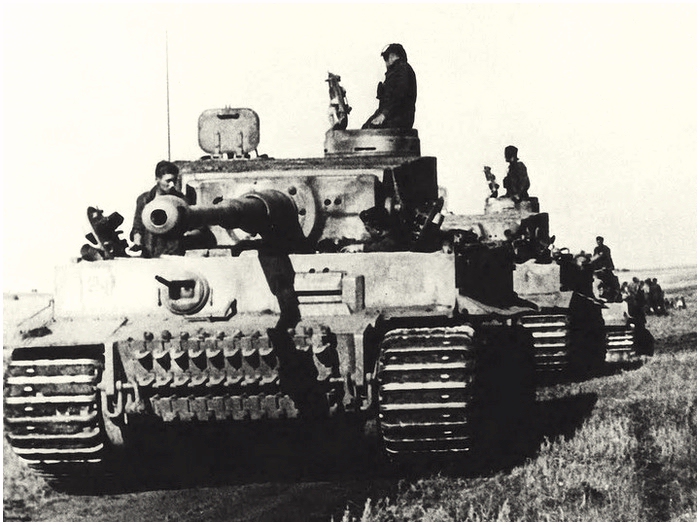
Tigers from SS-Panzergrenadier-Division
Leibstandarte 'Adolf Hitler'
On 5 July, 1943 Wittmann destroyed during Operation Zitadelle 13 T-34 tanks and 2 anti-tank guns.
A couple of days later, on 7 and 8 July, he destroyed another 7 Russian tanks (2 T-34, 2 SU-122 and 3 T-60/70 tanks).
On 12 July he destroys 8 Russian tanks plus 3 anti-tank guns and a fieldbattery. When the operation comes to
a closure on 17 July, Wittmann his score is 30 Russian tanks and 28 guns. On 29 July, 1943 the 13 Kompanie is
reformed to become the Schwere SS Panzer Abteilungen 101 which is connected to the LSSAH. In August the LSSAH
is deployed to Italy. In October the 1. SS-Panzer-Grenadier-Division 'Leibstandarte SS Adolf Hitler' becomes
the 1. SS Panzer Division LSSAH. In the same month, the division leaves again for Russia. On 13 October,
Wittmann scores 20 T-34 tanks and 23 other cannons.

Michael Wittmann with the 'Ritterkreuz mit Eichenlaub'
On 13 January, 1944 Michael Wittmann receives the Ritterkreuz (Knights Cross) for his devotion.
According to the propaganda machine, that announces it over the radio, Wittmann his score is then;
88 tanks and selfpropelled guns destroyed. A couple of days later, his gunner, SS-Rottenfuhrer Balthasar
(Bobby) Woll, receives the Iran Cross for his great marksmanship, even when the tanks is in motion. On
20 January, 1944, Wittmann is promoted to SS-Obersturmfuhrer. Two weeks later, on 30 January, Wittmann
receives a telegram from Hitler with the announcement, that Wittmann had become the 380th German soldier,
who gets the Oakleaves to the Knights Cross of the Iron Cross. On 20 February he receives the additions,
in the Wolfsschanze, from Hitler himself.
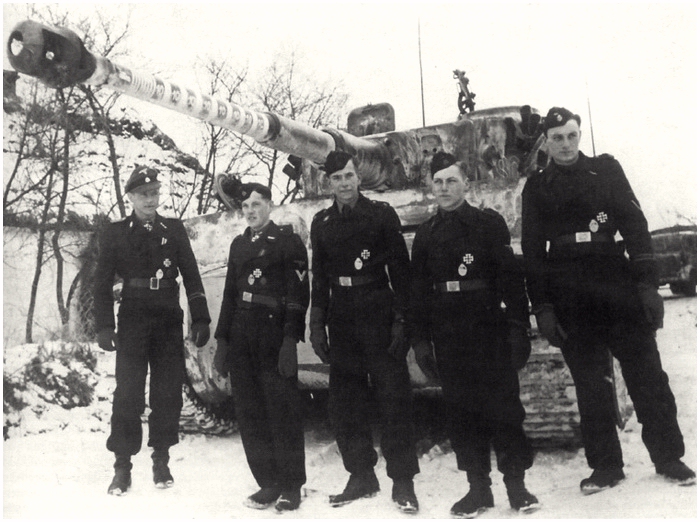
Untersturmführer Michael Wittmann, Rottenführer Bathasar Woll (gunner),
Panzeroberschütze Werner Irrgang (loader), Panzerschütze Sepp Rosner
(radio/bowgunner) and
Sturmmann Eugen Schmidt (driver)
(Notice the 88 stripes on the barrel of the 8,8cm gun of Tiger S04)
From 29 February till 2 March 1944, the largest portion of the company is moved to Mons, Belgium.
Around this period, Wittmann gets the command over 2. Kompanie, sSSPzAbt 101, LSSAH. On 2 March Michael
Wittmann marries Hildegard Burmester, witness is Bobby Woll. Meanwhile Wittmann becomes a hero to the
people. In April he visits the Henschel und Sohn factory in Kassel where the Tiger I is produced.
Here he is shown the latest version of it, the Ausf.
E.
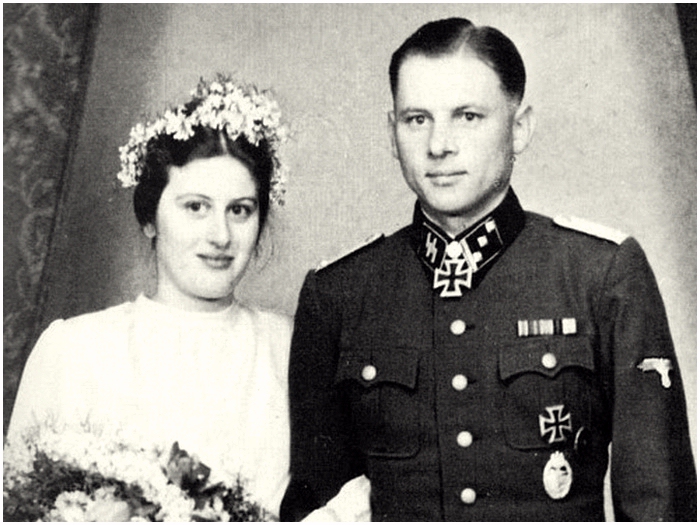
Michael Wittmann was married on 1 maart 1944 with Hildegard Burmester
In May, Wittmann returns with to his sSSPzAbt 101, LSSAH. These are then stationed near Lisieux in
Normandy. Around this time, Bobby Woll, his faithful gunner, is given his own command over a Tiger
I (de ‘335’). He would fight in Normandy and get wounded near Bayeux after an attack of fighterbombers.
Woll would see action again during the Battle of the Bulge, end of 1944, in a Tiger II. Woll
passed away in 1996.
During the invasion on 6 June 1944, the Schwere SS Panzer Abteilungen 101, 1st SS Panzer Division,
‘Leibstandarte SS Adolf Hitler’ was a reserve unit connected to the Panzer Lehr Division (which had
also the command over the 12. SS Panzer Division ‘Hitler Jugend’). sSSPzAbt 101 was at that moment under
command of Heinz von Westernhagen (Tiger ‘007’). Commander of 1. Kompanie was SS-Haubtsturmführer
Rolf Möbius, of 2.
Kompanie SS-Obersturmführer Michael Wittmann and of 3. Kompanie, SS-Obersturmführer Hanno Raasch was the
commander.

Tiger '331' of the 3. Kompanie, sSSPzAbt 101 in Normandy
On 6 June (D-Day) Wittmann received a new Tiger, the ‘205’ in which he moved of towards the front.
During the deployment he lost six of his original twelve Tiger tanks that were under his command
in 2. Kompanie. This was due to Allied fighterbombers and technical failure of the tanks. On 12 June,
they went into a bivouac for the night, north-east of Villers-Bocage. The next day, Wittmann went definitely
into the history books.
Early in the morning of 13 June Wittmann and six Tiger tanks were in a bivouac
near the RN175 (today the D 675), the road from Villers-Bocage towards Caen, when suddenly a
long column of tanks and vehicles, belonging to the British 7th Armoured Division, stopped at
‘Point 213’, so called by the British. Wittmann did not hesitate a second and ordered to start up
the Tigers. That was easier said than done, three tanks were malfunctioning, and even Wittmann
had to swap his tank.
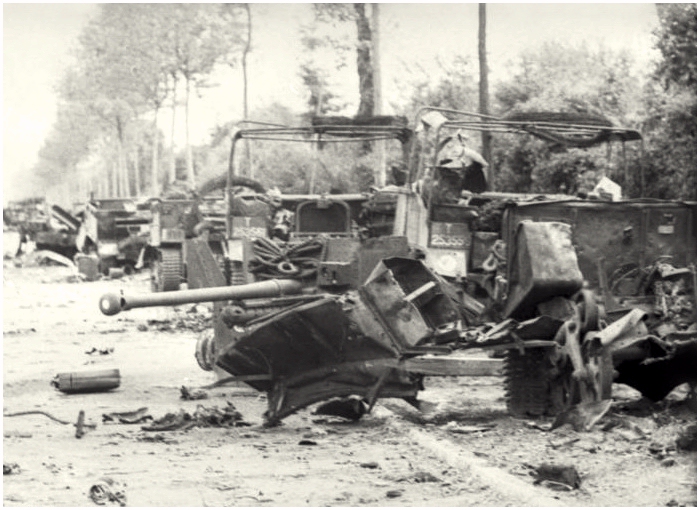
A part of the destruction by Wittmann his Tiger
In the short span of time, Wittmann and his Tiger were operating in and around Villers-Bocage,
the score was significant:
Near 'Point 213': 1 Cromwell IV and a Sherman Firefly (A Squadron, 4th CLY).
On route on the D 675 to Villers-Bocage: 8 Half-tracks, 4 Carriers, 2 6-pounder anti-tank guns
(A Company, 1st Rifle Brigade).
Entering Villers-Bocage: 3 M3A3 Stuart V, 1 Half-track, 4 Cromwell IV,
1 Scout Car, 1 Carrier (RHQ Troop en Reconnaissance Troop).
In the centre of Villers-Bocage: 1 Sherman OP en 1 Cromwell OP (5th RHA)
For the whole story of Wittmann in Villers-Bocage
CLICK HERE

A picture of Michael Wittmann just after his successful action
in Villers-Bocage, he is still 'loaded',...
On 22 June, 1944, after the success in Villers-Bocage, Wittmann received the Swords to his Knights
Cross with Oakleaves (after recommendation of the commander of Panzer Lehr, Generalleutnant Fritz Bayerlein),
from the hands of SS-Obergruppenfuhrer und Panzergeneral der Waffen SS Josef ‘Sepp’ Dietrich, commander of the
LSSAH. On 25 June the ceremony was repeated, when Wittmann received the same Swords from Hitler. With these,
Wittmann became the most decorated tanker of the Second World War. He also was promoted to SS-Haupsturmfuhrer.
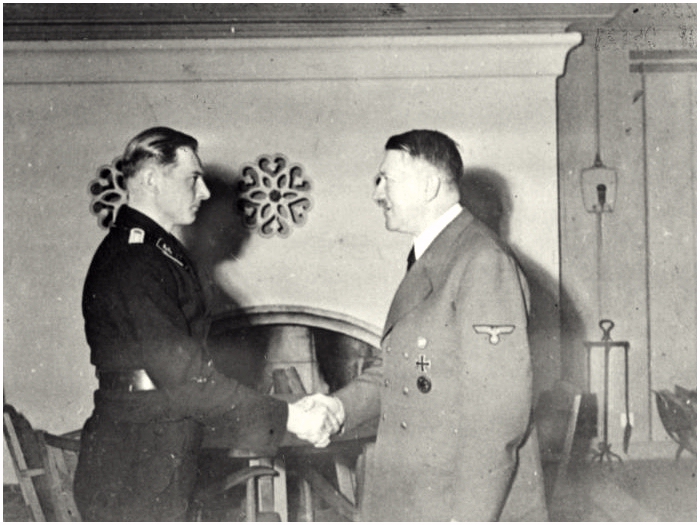
Michael Wittmann with Adolf Hitler on 25 June, 1944
Wittmann was given the post of instructor, but he choose the front instead of a school, and went back to
Normandy. During the month of July, 1944 he fought in the Battle for Caen. Early August, Wittmann received as
Abteilungskommandant, again a new Tiger I, the ‘007’ in which he operates on 8 August in the area of
Cintheaux. At 12.55 hours, the Tiger from Wittmann was hit in a field next to the road of Caen- Cintheaux,
near Gaumesnil. The explosion blows the turret clean out of the hull and all of the crew was killed. After the fighting,
the bodies are buried in a pit next to the remnants of Tiger ‘007’. In March 1983, while working on the new
N 158, human remains are found. After research it was concluded that remains belonged to Wittmann and his crew.

Pz.Kpfw.VI Ausf.E Tiger '007'
For years it was uncertain where the body of Wittmann was buried. Also was unclear what the cause for the
destruction was of ‘007’. One of the options was that the Tiger was destroyed by a rocket from a fighterbomber.
After investigation by Serge Varin, who had found ‘007’, he concluded that it was struck by a HE rocket from a RAF
Typhoon. He did not find penetration holes of grenades, but there was just one big hole in the thin (25mm) engine
top cover. On 8 August Typhoons where responsible for the destruction of 135 German tanks. Research showed that the 2nd
TAF was operating, but in the vicinity of Falaise and Argentan. But there were also
different tank units which claimed the destruction of ‘007’, such as the 1st Polish Armoured Division, but they
are not responible, because the Polish tanks appeared an hour later at the scene.
Operation 'Totalize'
An Allied outbreak from Caen towards Falaise started on 8 August 1944 with Operation
‘Totalize’. The attack was under command of the 2nd Canadian Corps led by General Simonds.
On 7 August positioned were taken up on the eastern flank by the Britsh 51st Infantry Division, consisting
of the 154th Highlands Brigade and the
33rd British Armoured Brigade. On the western flank, the 2nd Canadian Infantry Division, consisting
of the 4th
Infantry Brigade and the 2nd Armoured Brigade. When the attack was under way, the 3rd Canadian Infantry
Division and 49th British Infantry Division would attack the German defense, and the 1st Polish Armoured
Division and the 4th Canadian Armoured Division would break through towards Falaise. In the evening of
7 August, at 23.00 hours, an Allied bombardment took place to soften up the German defense. Afterwards
the first wave of ground troops headed out. Despite that some tanks got stuck in the bomb craters, there
was good progressing. The global line of attack was southwards with as a central line, the RN 158 towards
Falaise.
In Cinthaux, the commander of 12. SS Panzer
Division ‘Hitlerjugend’, SS-Oberführer Kurt Meyer, saw a very large pack of hundreds of
tanks coming his way. Meyer had some 75 tanks to his disposal. Beside some
Pz.Kpfw.IV’s and Jagdpanzer IV’s, Meyer could deploy seven Tigers
under command of Michael Wittmann, in Tiger ‘007’.
Meyer planned an attack towards the high ground at Saint-Aignan-de-Gramesnil.
On the left of the RN 158 operated the 4th Canadian Armoured Division, and on the right the Britsh
Northamptonshire Yeomanry.

Canadian Sherman tanks prepare for the attack,...
At 12.30 hours the initial attack from the Canadian 4th Armoured Division
towards Cintheaux, started, but not before an aerial bombardment was done.
But many bombs fell short and some 300 Polish and Canadian soldiers were killed.
But the attack was on, and some progress was made, until they ran into three
Tigers, the ‘313’ (SS-Hauptsturmführer Hans Höflinger), the ‘334’
(SS-Oberscharführer Rolf von Westerhagen, brother of Heinz) and the ‘304’(SS-Hauptsturmführer Franz Henrich).
Some Shermans fell victim to the 8,8’s from the Tigers, but the ‘313’ was also put out of action,
just as a Pz.Kpfw.IV. Höflinger and his crew managed to escape. The other two Tigers pulled back
to safety (for now).Around 12.55 hours, Höflinger looked to the right, the eastside of the RN 158, and
noticed that Tiger ‘007’, had come to a halt and stood on fire. And as he looked at it, the
turret blew out of the hull. As Höflinger looked further into the field, he saw three other Tigers
that were out of action.
At that moment there was no enquiry who or what unit was responsible for the carnage under the
Tigers. Speculating started after the war. 99% of the Allied soldiers were not acquainted
with the tank ace Michael Wittmann, and putting a Tiger out of action was no more than
stopping a dangerous enemy tank, regardless the commander in the turret.
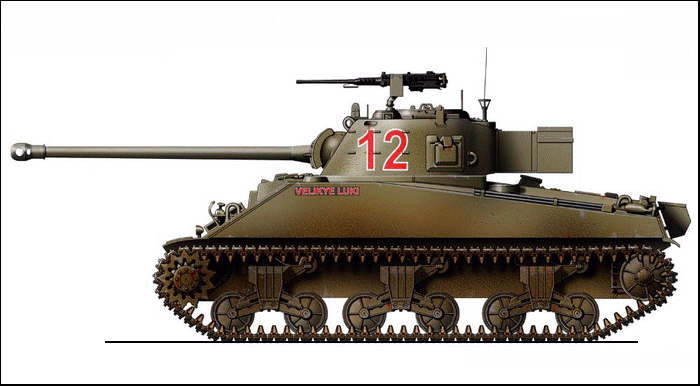
Sherman Vc Firefly, 3 Troop, A Squadron,
Northamptonshire Yeomanry
(Drawing: Vincent Bourguignon, War'tist)
Today, most accepted opinion is that Wittmann and his crew were killed from a shot of a Sherman Vc
Firefly, from 3 Troop, A Squadron, Northamptonshire Yeomanry. This Firefly, the ‘Velikye Luki’, under command of
Sergeant Gordon was operating with other Fireflies when they encountered three Tigers.
according to after action reports, they fired on these
Tigers which were all three destroyed in a couple of minutes. All three Tigers were
put out of action by the 19 year old gunner Trooper Joe Ekins from the Firefly of Sergeant
Gordon. The last Tiger in line was the first one to be stopped by Ekins at 12.40 hours, so
the others in front of it would not notice it. The second one, who managed to fire one shot at
the Firefly, but missed, was hit by Ekins and stopped. It exploded around at 12.47 hours. According
to verbal testimony many years after the war by Firefly gunner
Trooper Joe Ekins, that had to be the Tiger ‘007’. The last Tiger
was stopped with two grenades from Ekins his 17 pounder.
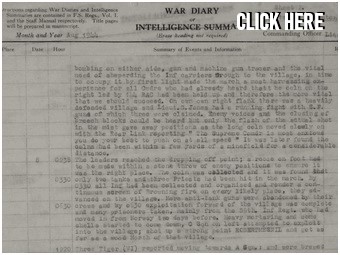
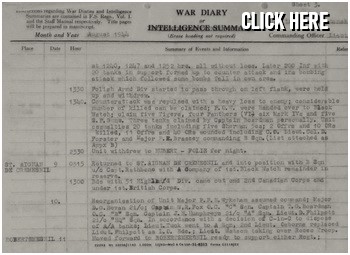
After action report A Squadron, Northamptonshire Yeomanry, 8 August 1944
(click on the reports for enlargement)
But over the years some doubts have been arisen about these claims.In the after action reports
from A Squadron they mention three Tigers that were ‘brewed up’ between 12.40 and 12.50
hours, but there were four Tigers stopped in that field,… Later in the report, at 13.40 hours,
five Tigers are mentioned (was this the total score of the morning?), but three were claimed by
Captain Boardman, the commander of the unit with the Firefly from Sergeant Gordon and gunner Ekins.
The same report shows a loss of 20 tanks for the British unit, among them five Shermans.
The last years extensive research was done to point the one who was responsible for putting ‘007’
out of action.
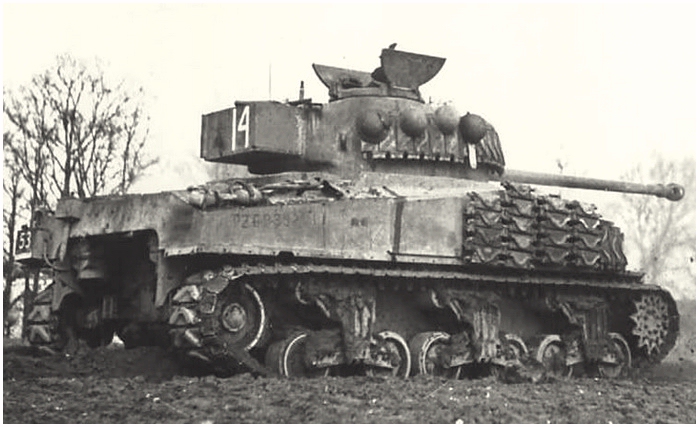
A Sherman Vc Firefly, of the 27th Canadian Armoured Regiment,
Sherbrooke Fusiliers, 2nd Canadian Armoured Brigade
To the west of the RN 158, near the hamlet of Gaumesnil, stood a small castle with a long stretch
of wall surrounding it. A couple of Shermans, among them a single Firefly, from
van A Squadron, 27th Canadian Armoured Regiment,
Sherbrooke Fusiliers, a unit of the 2nd Canadian Armoured Brigade, broke through the wall to have a
clear view of fire, and still be somewhat protected. They were just in time to witness the four
Tigers under command of Wittmann to come into view and to come under fire from
the Northamptonshire Yeomanry. The Canadian held their fire, until a single Tiger rolled into
their field of fire (was this the ‘007’?). With a single shot from the Canadian Firefly, it was stopped.
A fire was started inside the tank, followed by an enormous explosion that blew the turret out of the hull.
All of this is from verbal history only, because the after action reports from this Canadian unit was
destroyed when their HQ on wheels was hit by enemy fire and destroyed. But there is some strong evidence
that the Canadians were responsible for hitting ‘007’.
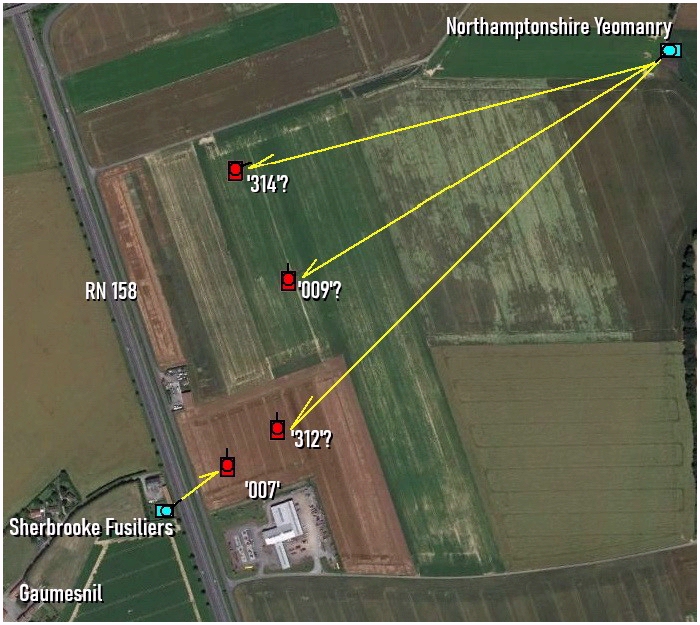
Situation on 8 August 1944, ± 12.50 uur
The position of the Tigers, under Wittmann on the right flank, as they drove
into the field is open to speculation. Probably was ‘009’, SS-Untersturmführer
Helmut Dollinger, second in command after Wittmann, second in lineof the attacking Tigers.
SS-Sturmmann Alfred Bahlo, radio operator and bow gunner of ‘009’, declared later that their tank
was hit and that SS-Oberscharführer Johann Schott, loader, was badly hurt.
The crew managed to escape the stricken Tiger and they tried to stop another Tiger
to help them, but, according to Bahlo, the other Tigers were planning to withdraw and were
not noticing the crew of ‘009’.
The ‘314’ under command of SS-Untersturmführer Willi Iriohn passed them without stopping,
and Bahlo noticed another Tiger knocked out.Could that be the ‘312’under command of
SS-Oberscharführer Peter Kisters? Bahlo managed to bring, with help from other crew members,
the wounded Schott to the RN 158 where he was put in a
Kübelwagen that brought him towards Falaise. The ‘312’and the ‘314’belonged to
101. 3.Kompanie and were attached to Wittmann.
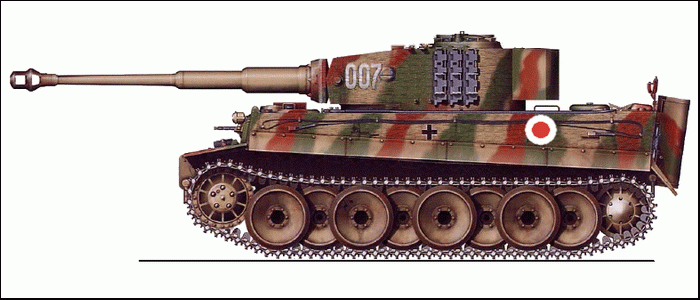
According to some sources, the red dot was the position
where '007' was struck (from Canadian position)
One thing is for certain, Wittmann in ‘007’ was moving left from the other three
Tigers, and probably a bit behind another Tiger (possibly ‘312’).
The after action report by
Northamptonshire Yeomanry gives testimony that there were three Tigers (all stopped by Joe
Ekins which was the only Firefly operating from the edge of the woods, now gone) from a distance of
around 750, 800 yards. Ekins verbal report says that when he hit the last Tiger in line,
he moved his turret to the right for the next target.
Could it be, that ‘007’ from Wittmann was
behind ‘312’ in a dead spot, and not visible to Ekins? And that a short time later ‘007’ rolled
into view of the Canadian Firefly behind the castle wall from Gaumesnil?
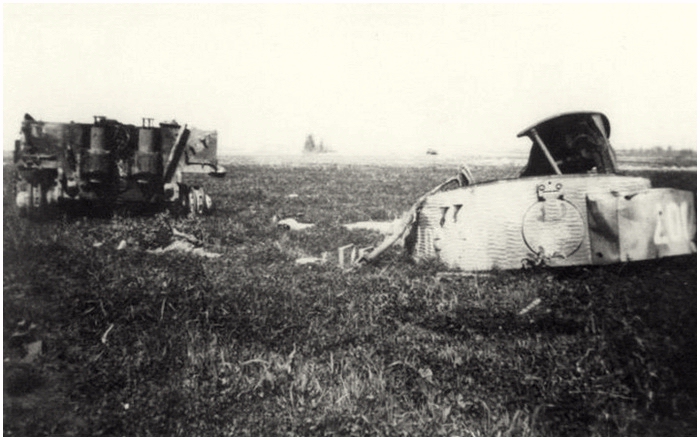
Tiger '007' with the turret blown from the hull to the right
(photo; Serge Varin)
During a reconstruction for a TV documentary the makers mentioned that Wittmann his Tiger
was out of reach for the 17 pounder (76,2mm) from Joe Ekins his Firefly. The vertical armour above
the tracks of a Tiger is 3.2 inches (8cm) thick. Even if ‘007’ was at a 1000 yards distance from the
Yeomanry Firefly, an Armoured Piercing, Capped, Ballistic Capped
(APCBC) shell could penetrate through 4.7 inch (12cm) armour, even if it stood under an angle of
30°). As far a distance of 1950 yards (1800 meters)a grenade from a Firefly could penetrate 3.5 inch
(9cm) armour. During august 1944 a new grenade was distributed for the 17 pounder, the Armoured
Piercing Discarding Sabot (APDS), that could penetrate 7.25 inches (18.5cm) from a distance of a
1000 yards, but the shell was not as stable above the 1000 yards as the APCBC (it is uncertain if
Joe Ekins had access to the APDS). But one thing is certain, the Tigers under command of
Wittmann were within reach of the 17 pounder Firefly from Ekins and without doubt in reach of
the Canadian Sherbrooke Firefly,…
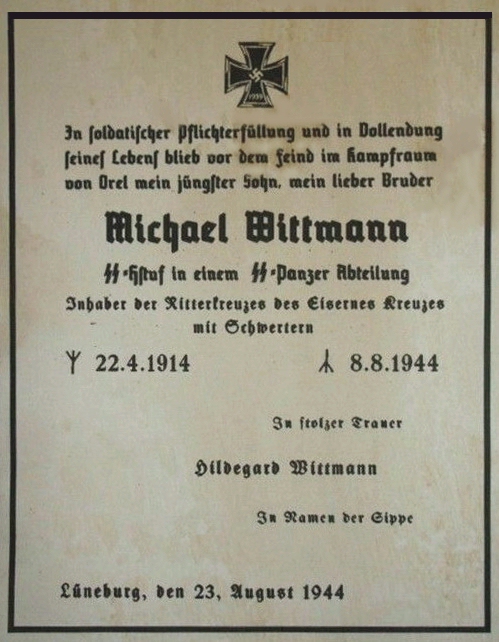
After the remains were found of Wittmann and his crew, they were reburied at the German war cemetery at
La Cambe, where it is attracting many visitors. Unfortunately there are people who think it is necessary
to bring extreme rightwing and fascistic items to their grave. Wittmann was an SSer (he was known as a fanatic
‘heel clicker’) and fought for a rotten regime. Despite that context, his heroism may not be forgotten. He was
very popular among his comrades and showed sometimes, during the dirty fighting at the East front, his human
side. As mentioned before, crewmembers who jumped burning from their destroyed T-34 had their flames put out by blankets
from Wittmann and his crew and were handed over to the medical service.

The grave of Wittmann and his crew in the cemetery of La
Cambe
But Michael Wittmann was a cold blooded tanker
who seemed unstoppable and which was ultimate leading to his death.
The total score of victories for Wittmann till 8 August, 1944 was 141 tanks and
132 anti-tank guns. Most of these victories were made on the Eastern front. The German cemetery at La Cambe can be
found on the N 13 (global central between Bayeux and Carentan).
Wittmann and his crew are buried in lot 47, row 3 and grave 120.
BACK
|